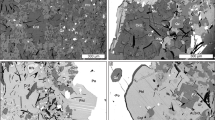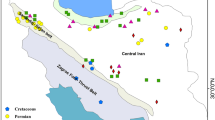Abstract
The states of S species in black shales are very complex, such as organic sulfur, pyrite sulfur and sulphate sulfur. The mineral microtexture, sulfur content and sulfur isotope can indicate the formation conditions and diagenetic processes of the black shales. The S species are separated perfectly and the relation between the content, mineral microtexture and sulfur isotope composition of the sulfur mineral is assessed. These complementary approaches provide people a new insight into the formation conditions of the black shales and redox conditions of Precambrian and Cambrian in Southwest China.
Similar content being viewed by others
References
Li, R. W., Organic matter of Early Paleozoic sedimentary rocks in Yangtze Platform and its relevance to concentration of some chemical elements,Resource Geology Special Issue (in Chinese), 1993(15): 123.
Chu, X. L., Zhao, R., Zang, W. X., The preparation of isotope and the separation of S species in coal and sedimentary nicks,Chinese Science Bulletin (in Chinese), 1993, 38(20): 1887.
Wilkin, R. T., Barnes, H. I.., Barantley, S. L., The size distribution of framboidal pyrite in modern sediments: An indicator of redox conditions,Geochimica et Cosmochimica Acta, 1996, 60: 3897.
Berner, R. A., Sedimentary pyrite formation: an update,Geochim. Cosmochim. Acta, 1984, 48: 605.
Carrigan, W. J., Cameron, E. M., Petrological and stable isotope studies of carbon and sulfide minerals from the Gunflint Formation, Ontario: evidence for the origin of early Proterozoic iron-formation,Precambrian Res., 1991, 52: 347.
Duan, W. M., Chen, L. R., The history of pyrite formation in the early diagenetics process in Yellow Sea and East Sea,Science in China (in Chinese), Series B, 1993, 23(5): 545.
Raiswell, R., Berner, R. A., Pyrite formation in euxinic and seimi-euxinic sediments,American Journal of Science, 1985, 285: 710.
Passier, H. F., Middelburg, J. J., de Lange, G. J., Boettcher-Michael-E, Pyrite contents, microtextures, and sulfur isotopes in relation to formation of the youngest castern Mediterranean sapropel,Geology (Boulder), 1997, 25(6): 519.
Jiang, Z. Y., Wei, L. M., Chen, M. Y., Sulfur isotopic study of sulfides from sedimentary strata and strata-bound deposits in Hunan, Guangdong and Guanxi of Southern China,Geochimica, ACAS (in Chinese), 1990(2): 117.
Strauss, H., The sulfur isotopic record of Precambrian sulfates; new data and a critical evaluation of the existing record,Precambrian Research, 1993, 63(3-4): 225.
Author information
Authors and Affiliations
About this article
Cite this article
Wu, C., Zeng, F., Lei, J. et al. Referential significance of sulfur isotopes and separation of S species in black shales of Southwest China. Chin.Sci.Bull. 44, 1612–1616 (1999). https://doi.org/10.1007/BF02886104
Received:
Issue Date:
DOI: https://doi.org/10.1007/BF02886104




